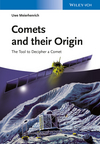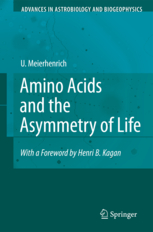Within the Rosetta mission of the European Space Agency (ESA), Darmstadt, Germany, the Philae lander made the first soft landing on a comet nucleus by touching down on comet 67P/Churyumov-Gerasimenko in 2014. Philae carried out eleven experiments.
Comets largely consist of condensed ices and dust and circle the sun on elliptical orbits. They are remnants of the birth of our solar system and are therefore important witnesses from ancient times.
Professor Uwe Meierhenrich, University of Nice Sophia Antipolis, France, is known for his research on the identification of amino acids in space and was involved in the preparation and realization of the Rosetta mission.
What got you interested as a chemist in space research?
During my PhD thesis, I became fascinated by stereochemistry and chirality-related questions. I wanted to know why biological organisms develop proteins that contain exclusively L-enantiomers of amino acids and genetic material that specifically employs units in D-configuration. To understand this evolutionary period called biomolecular symmetry breaking, we need to understand and reproduce the formation of the first organic molecules, of chiral molecules, if possible. Experiments used on a space mission like Rosetta are unique and can help us to find answers to these fundamental questions.
How did you get involved in the Rosetta mission?
In 1997, I was fortunate to receive a postdoctoral scholarship. I worked at the Max Planck Institute for Solar System Research in Katlenburg-Lindau, now in Göttingen, with the group of Helmut Rosenbauer. There I became part of the team responsible for the instrumentation of the Rosetta lander called Philae that was planned to land on a cometary nucleus in 2014.
The Rosetta mission, in fact, is the first space mission to try a soft landing on a cometary nucleus by carefully depositing a small robotic laboratory on a cometary nucleus. The Philae laboratory contains eleven instruments and I was involved in – in my point of view – the most fascinating one: the Cometary Sampling and Composition (COSAC) equipment. COSAC is a gas chromatograph (GC) coupled to a mass spectrometer (MS).
Helmut Rosenbauer started to design and construct the COSAC GC-MS in Germany at the Max Planck Institute at the time when I was a postdoctoral researcher in his group.
So this was in 1997, the Rosetta mission launched in March 2004, and Philae landed on the comet in November 2014 and sent data back. What did you do in the meantime?
First, we had to meet strict deadlines and finish construction of the hardware of the instruments and plan the experiments for the space mission. If you don’t keep to your deadlines in space science, your instrument will not fly. So we were working under high pressure. But it turned out well.
In addition, if you are a postdoctoral researcher in a very good institute and you want to stay in science, you have to publish. So what I published at that time in 1999, for example, together with Rosenbauer and Thiemann, was the design of the COSAC GC-MS for the Rosetta lander Philae. However, this design is not something a very good journal like Angewandte Chemie or Nature would publish. It is of more interest for a specialist journal. So I decided to test the GC-MS we developed for Rosetta with an artificial comet.
In this context, I contacted the astrophysist professor J. Mayo Greenberg at Leiden University in The Netherlands. Greenberg knew how to reproduce an artificial comet in the laboratory and he was able to provide me through his PhD student Guillermo Muñoz Caro with some micrograms for my experiments.
Can you please describe these experiments with the artificial comet?
Greenberg introduced me to what we now call the Greenberg Model of Comet Formation: In interstellar space you have many molecules in the gas phase. So interstellar space is not empty. These molecules rotate and vibrate, a behavior that makes them detectable by various spectroscopic techniques. Greenberg argued that in an interstellar environment you also have what he calls interplanetary dust particles (IDPs). These are small silicate grains, smaller than a micrometer. Greenberg proposed that gas phase molecules of known molecular structure condense at low temperatures under irradiation of photons and form icy mantles. Tiny dust grains thereby become surrounded by thin icy mantles.
For the accurate laboratory simulation of these processes, Greenberg used a temperature of 12 K and Lyman-alpha photons, which correspond to an energy of 10.2 eV. Remarkably, the molecules that he condensed from the gas phase did not contain any carbon–carbon nor carbon–nitrogen bonds. They were just carbon monoxide (CO), carbon dioxide (CO2), water (H2O), ammonia (NH3), and methanol (CH3OH). So we talk about C1 and N1 units.
I got a sample from Greenberg and analyzed it with the COSAC GC-MS designed for Rosetta in our lab. Guillermo Muñoz Caro and I found 16 amino acids in the artificial comet. And nobody believed it because we only used C1 and N1 units for the simulation of the cometary ices. We repeated the experiments a second time and replaced all of the carbon atoms of the starting molecules with carbon-13 isotopes. We again found 16 amino acids and could clearly prove by mass spectrometry that all of the carbon atoms in the generated amino acids contained 100 % carbon-13. This was ultimate proof that all of the amino acids were generated by photochemical reactions under interstellar conditions from carbon monoxide, carbon dioxide, and methanol, the carbon carriers of the starting material.
An amazing result!
Yes, so we sent our results to Nature and they said immediately: publish, this is extremely important. This was our first common publication in Nature [1]. I was corresponding author and this turned out to be my scientific breakthrough.
It is important for young people to have one key publication that they did themselves and for which they get credit. I suddenly got in contact with many scientists I had previously only known from the literature. This, of course, was a changing point in my career. And the story continues: scientists from different disciplines use our data and heavily cite the work.
How did you follow up on this?
We continue to pursue the question of why biomolecules like amino acids only occur in the L-configuration in proteins.
In my lab here in Nice, we are equipped not only with many GC-MS instruments, but also with multidimensional gas chromatographs coupled to mass spectrometers (GCxGC-MS). This is a rather new technique providing very high resolution of analyses. So when we now repeat those earlier photochemical experiments we don’t see 16 amino acids, we see 30 amino acids. And many other colleagues, for example, those in the United States who repeat what we do, also see 30 amino acids.
In the experiment, we used Lyman–alpha photons because they are very abundant in space. Some astrophysicists, Jeremy Bailey from Australia in particular, detected circularly polarized electromagnetic radiation in space in molecular clouds out of which stars form. So photons in space can be chiral, circularly polarized. There are two forms of circularly polarized light providing right and left circular polarization and it is interesting to see that distinct regions in space are dominated by the right form, whereas the left form occurs in other regions. This finding was published in Science [2].
The photons we used were not polarized. The amino acids we have detected were racemic. So we replaced our non-polarized photons with circularly polarized photons and by doing so tried to transfer the chirality of the photon to the organic molecules. These are experiments that we do at the synchrotron facility SOLEIL in the South of Paris.
To come back to the Rosetta mission: Can you please say something about the data you have received?
The Rosetta mission required more than ten years to reach its target comet. The launch date was 2 March 2004. In August 2014 the Rosetta probe reached the comet 67P/Churyumov-Gerasmienko and in November 2014 the Rosetta lander Philae detached from the Rosetta orbiter and tried to land on the cometary surface of unknown chemical composition.
As you are probably aware, the Philae lander did not attach to the cometary surface after its first landing attempt. It bounced. This was very critical, because we were afraid that we would entirely lose contact with the Philae lander. Philae sends its data to the Rosetta orbiter, which then transmits the data back to Earth, which is a distance of around 500 million kilometers. We cannot directly receive data from the Philae lander from Earth, data-relay via the orbiter is required. The antennae of the Philae lander are installed on its top and if the lander were to tumble and land on its head, there is no contact. So we were very lucky that – after the final landing event – only one of Philae’s three legs was facing the vacuum above the cometary nucleus and two legs made contact with the ground, the icy cometary surface. A telemetry link was established.
On the cometary nucleus the weight of the Philae lander is 1 g, whereas it is 100 kg on earth. So Philae is very lightweight on the cometary nucleus. Our COSAC GC-MS is connected to the Sample Drilling and Distribution instrument SD2 that is constructed to drill into the cometary surface after landing. As Philae did not land properly, attempts to use the drill in horizontal manner might have caused the lander to fall on its antennae. Then the entire Philae mission would have been lost. Therefore, the other experiments on board Philae lander began their operations. Most of them were very successful and at the very end, which was then 14 November 2014, our COSAC instrument was switched on. I followed this event at the DLR Philae Lander Control Center in Cologne. Data from the COSAC sequence were successfully downloaded on Friday morning, envisaging the first and only COSAC sequence to measure GC-MS on a cometary surface.
One rotation of the comet around its axis takes 12 hours. With the Philae lander located on the small lobe of the cometary nucleus, we had a communication window between the lander and the orbiter for three hours. After the three hours the Philae lander disappeared on the far side of the cometary nucleus. So we always established telecommunication at nine in the morning and at nine in the evening, each time for three hours. The last operational sequence that was sent to the lander was on the Friday morning. It included demands for the operation of COSAC. After one cometary rotation, we expected to receive the GC-MS data. So it was nine o’clock in the evening and I was sitting with my colleagues in Cologne and there was no signal from Philae. At 10 pm, no signal. At 10:40 pm, no signal. And then I thought, maybe because we had employed the SD2 drill of the Philae lander for the first time, perhaps this operation had altered the orientation of the lander a little and therefore we had to look at another time window. And this is probably what had happened. At something like 11.45 pm, we got Philae’s signal. One of the most fascinating moments in my entire scientific life.
I remember that in the DLR headquarters where I was they had a big screen and the first line of this big screen said “COSAC data incoming”. And then there was a second line, “COSAC data incoming”. And then it was like being at an airport, chuck, chuck, chuck … one line after the other, until we had 420 lines. So we measured 420 mass spectra on the cometary nucleus for the first time and all of them were transmitted to Earth. This was the first ever GC-MS recorded on a cometary nucleus.
And what did these data show?
Prior to the landing of Philae on the cometary surface, we had to develop a scientific sequence – the so called first scientific sequence – that operates in an automatic mode immediately after having received the landing signal. This sequence included a COSAC measurement that was to occur twenty minutes after landing. But we now know that the Philae lander did not land after its initial landing attempt. The Philae lander bounced off the cometary surface and finally landed after two hours. So 20 minutes after the first bounce our MS was switched on. Of course, we did not know this would occur when we anticipated the whole scenario; the idea was to measure molecules in the ice and dust of the cometary surface. However, Philae was now about 450 meters above the cometary surface in the vacuum. There COSAC recorded a mass spectrum and this mass spectrum is full of signals that reveal the presence of organic molecules. It was published in the journal Science in July 2015 [3].
We did not find amino acids in this mass spectrum. But we detected, you could say, reactive precursor molecules of amino acids. For example, we found many aldehydes such as ethanal, propanal, and glycolaldehyde.
Is this something you can also see in experiments with an artificial comet?
Yes. By using our multidimensional gas chromatograph we see not only 30 amino acids in the simulated interstellar ice, but also many aldehydes. This was described in our first publication in 2015 in Proceedings of the National Academy of Sciences of the United States of America [4].
In the Rosetta COSAC mass spectrum, we cannot see amino acids at an altitude 450 meters above the cometary nucleus. Amino acids are refractory. To detect them we would have to employ the COSAC GC-MS on the surface of the nucleus. So the situation now is that we are very happy with the data already received from Philae, but we hope that Philae will wake up again. This has to happen until January 2016.
What is the problem with Philae at the moment?
Philae’s batteries are assumed to be charged and the temperature is sufficiently high in Philae’s interior, in the so-called warm compartment. The problem is that at present the Rosetta orbiter is too far away from the Philae lander. We are at a distance of 1400 km from Philae right now and there is no hope to receive the Philae lander signal. In the coming days the Rosetta orbiter will approach the cometary nucleus again and will get closer to the nucleus and then we hope to receive a signal to the Philae lander and reestablish a stable telemetry link.
In this context, it is interesting to mention that the Rosetta orbiter is equipped with two independent star trackers. From November 2014 until today these trackers have failed four times because they falsely took more than 350 dust particles that were ejected from the cometary nucleus and illuminated by sunlight for stars.
Four times, both star trackers failed. So when this became known, the orbiter was immediately shifted far away from the cometary nucleus. Both star trackers were successfully booted up again. This allowed for the spatial re-orientation of the Rosetta probe. Two times we were close to losing Rosetta. To avoid losing the mission, officials try to avoid getting too close to the cometary nucleus, because there the density of the dust particles is dangerously high.
You should know that the comet is an agglomeration of tiny dust particles each containing a water-ice mantle. This is the Greenberg model. The comet moves on an elliptical trajectory around the Sun. The closest distance of the cometary nucleus to the Sun is called the perihelion. The comet’s passage through perihelion was on 13 August, this year. Now the comet is moving away from the Sun and the temperature of the comet surface drops. Philae can only tolerate temperatures to –50 °C inside; if it gets too cold, it will shut down. This might happen end of January 2016 when the Philae mission will probably end. But this is difficult to predict because we do not know the precise position of the Philae lander and the solar irradiation conditions. The Roseta mission will continue and probably finish by depositing the Rosetta orbiter on the cometary nucleus by the end of 2016.
So it is still very exciting. Why do you think the Rosetta mission is not only a huge success for ESA and European science, but also very popular?
I do not know, but it definitely is. There are many people thinking about how we can again gain contact with the Philae lander. I received an email asking why we don’t use lasers to illuminate the Philae lander and thereby charge the battery. Whether this is useful or not, it shows that many people somehow became attracted to science, by scientific investigations, by the landing on the comet.
It seems to me that the Rosetta mission and Philae lander are even more interesting to the public than most of the recent rover missions to Mars. There have been many missions to Mars, but as yet they have not convincingly identified any organic molecule on the surface of Mars.
A cometary nucleus is black, because there is a multitude of organic molecules in the cometary nucleus and on its surface. Comets provide fascinating pristine organic chemistry. And this is one reason why the Rosetta mission is highly successful.
Will you participate in another space mission after Rosetta?
Prior to Rosetta, Europe had a space mission to comet 1P/Halley called Giotto in 1986. A special issue of Nature reported on scientific data obtained from Giotto. Giotto was a comet flyby mission. The spacecraft flew with a relative velocity of 68 km/s, passed the cometary nucleus of 1P/Halley, and took photos until the camera got stuck because of colliding cometary dust particles.
In the Rosetta mission we followed a cometary nucleus during perihelion passage, and approached it for landing.
Without the technical knowledge from the 1986 Giotto mission, the Rosetta mission would not have been possible. Many of the instruments, for example, the mass spectrometers, cameras, and dust impact sensors, had already been used on Giotto. But thirty years later instruments were redesigned and constructed with a much higher performance, often by the same scientific team. Thereby, Rosetta is a mission in which you have a lot of knowledge transfer between generations. Established scientists successfully gave their knowledge to the younger generation. These younger people only succeeded because of the help from the previous generation. Without Peter Eberhardt, Mayo Greenberg, Franz Krüger, Colin Pilinger, Helmut Rosenbauer and many others, Rosetta would not have been possible.
To come back to your question, of course, the scientific community would like to see another cometary mission realized. It is now feasible to soft-land on a cometary nucleus again and then bring a nucleus sample back to Earth. If we would have pristine cometary material available in our lab, we could profit from the tremendous evolution of our analytical instruments for its characterization. Remember that the Rosetta mission took more than ten years from launch to Philae landing and meanwhile our analytical equipment on Earth are more sensitive.
ESA accepted and appreciated our COSAC instrument to fly to Mars in the frame of the the ExoMars mission. The launch date of the ExoMars rover mission is scheduled for 2018. This is perfect. The considerable reconstruction and modification of the COSAC instrument that will go to Mars is a challenge for all of us. The instrument will be called Mars Organic Molecule Analyser (MOMA).
So we keep our fingers crossed for you. Besides your research, what other interests do you have?
I live at the French Côte d’Azur, with its magnificent Alpes-Maritimes landscape, Mediterranean cuisine, pleasant weather.
My favorite hobby became cycling. I live in a small adorable village close to Nice called Cap d’Ail. I use my bike to go from there to the university every day via the so-called ‘basse corniche’, which is 20 km, so a 40 km return trip. 200 km per week; 6000 km per year. Regular cycling is a pleasure for me because I like the appreciable Alpes-Maritimes landscape, the activity helps to refresh my thoughts and I like to put some spatial distance between university and private life.
Thank you very much for the interview and for sharing these very exciting experiments with us.
References
[1] Amino Acids from Ultraviolet Irradiation of Interstellar Ice Analogues, G. M. Muñoz Caro, U. J. Meierhenrich, W. A. Schutte, B. Barbier, A. Arcones Segovia, H. Rosenbauer, W. H.-P. Thiemann, A. Brack, J. M. Greenberg, Nature 2002, 416, 403–406. DOI: 10.1038/416403a
[2] Circular Polarization in Star-Formation Regions: Implications for Biomolecular Homochirality, J. Bailey, A. Chrysostomou, J. H. Hough, T. M. Gledhill, A. McCall, S. Clark, F. Menard, M. Tamura, Science 1998, 281, 672–674. DOI: 10.1126/science.281.5377.672
[3] Organic Compounds on Comet 67P/Churyumov-Gerasimenko Revealed by COSAC Mass Spectrometry, F. Goesmann, H. Rosenbauer, J. H. Bredehöft, M. Cabane, P. Ehrenfreund, T. Gautier, C. Giri , H. Krüger, L. Le Roy, A. J. MacDermott, S. McKenna-Lawlor, U. J. Meierhenrich, G. M. Muñoz Caro, F. Raulin, R. Roll, A. Steele, H. Steininger, R. Sternberg, C. Szopa, W. Thiemann, S. Ulamec, Science 2015, 349, 497. DOI: 10.1126/science.aab0689
[4] Aldehydes and Sugars from Evolved Precometary Ice Analogues: Importance of Ices in Astrochemical and Prebiotic Evolution, P. de Marcellus , C. Meinert , I. Myrgorodska , L. Nahon, T. Buhse, L. Le Sergeant d’Hendecourt, U. J. Meierhenrich, Proc. Natl. Acad. Sci. 2015, 112(4), 965–970. DOI: 10.1073/pnas.1418602112
 Uwe Meierhenrich, born 1967 in Detmold, Germany, studied chemistry at the Philipps-University Marburg, Germany, and gained his Ph.D. in Physical Chemistry from the University of Bremen, Germany. He was Post-doc at the Max Planck Institute for Solar System Research, Katlenburg-Lindau, Germany, and at the French Synchrotron Center LURE. In 2003 Meierhenrich obtained his habilitation with the academic publication “The Origin of Biomolecular Asymmetry” from the University of Bremen.
Uwe Meierhenrich, born 1967 in Detmold, Germany, studied chemistry at the Philipps-University Marburg, Germany, and gained his Ph.D. in Physical Chemistry from the University of Bremen, Germany. He was Post-doc at the Max Planck Institute for Solar System Research, Katlenburg-Lindau, Germany, and at the French Synchrotron Center LURE. In 2003 Meierhenrich obtained his habilitation with the academic publication “The Origin of Biomolecular Asymmetry” from the University of Bremen.
Since 2005, Meierhenrich is professor for Analytical and Physical Chemistry at the University of Nice Sophia Antipolis in France.
Selected Awards
- 2011, Horst-Pracejus-Prize of the GDCh
- 2015, Professeur de Classe Exceptionnelle
Selected Publications
- U. J. Meierhenrich, Comets and their Origin – The Tool to Decipher a Comet, Wiley-VCH, Weinheim 2015. ISBN: 978-3-527-41281-5
- U. J. Meierhenrich, Amino Acids and the Asymmetry of Life, Springer, Heidelberg 2008. ISBN 978-3-540-76886-9
- I. Myrgorodska, C. Meinert, Z. Martins, L. Le Sergeant d’Hendecourt, U. J. Meierhenrich, Molecular chirality in meteorites and interstellar ices, and the chirality experiment on board the ESA cometary Rosetta mission, Angew. Chem. Int. Ed. 2015, 54, 1402–1412. DOI: 10.1002/anie.201409354






Very nice interview with an admirable young scientist with an exciting career. I find the organic asymmetry a very exciting clue about life origin and I had investigated it from a rather different perspective. I will love to discuss this ideas with Meierhenrich, someday!
“Unfortunately, the probability of Philae re-establishing contact with our team at the DLR Lander Control Center (LCC) is almost zero, and we will no longer be sending any commands; it would be very surprising if we received a signal now,” said Stephan Ulamec Philae Project Manager of the German Aerospace Center (Deutsches Zentrum fuer Luft- und Raumfahrt; DLR) today.
The Rosetta spacecraft will continue to orbit the comet and carry out measurements until September 2016.
More at DLR’s website
The Electrical Support System (ESS) on Rosetta, which is used to communicate with Philae, is switched off today to save energy. On September 30, the Rosetta mission will come to an end.
More at DLR’s website